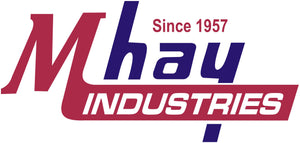Practical Tips for Maintaining Your Veterinary Tools
Recent Post
Archive
- December 2023
-
- The Veterinary Tools Revolution: A Journey Towards Advanced Animal Care
- Mhay Industries: A Testament to Quality and Innovation in Veterinary Tools
- A Look Behind the Scenes: How Mhay Industries' Tools are Made
- Expanding Your Veterinary Practice: Essential Tools in Your Arsenal
- The Role of Proper Equipment in Successful Small Animal Surgeries
- Global Recognition: Mhay Industries' Veterinary Tools Trusted Worldwide
- Veterinary Tools: A Comprehensive Buying Guide
- Animal Health and Welfare: Essential Tools in Handling Small Animals
- The Impact of Quality Tools on Your Veterinary Practice
- The Role of Veterinary Tools in Animal Rescue Centers

Practical Tips for Maintaining Your Veterinary Tools
Dec 14, 2023
As a dedicated veterinary professional, the quality and longevity of your tools are crucial to providing optimal care for your furry patients. Proper maintenance not only ensures the effectiveness of your instruments but also contributes to a safe and efficient working environment. In this blog post, we'll explore practical tips for maintaining your veterinary tools, helping you extend their lifespan and uphold the highest standards of healthcare.
1. Regular Cleaning and Sterilization:
Start with the basics – regular cleaning and sterilization. After each use, promptly clean your veterinary tools to remove any debris, blood, or contaminants. Follow this with proper sterilization procedures to eliminate harmful bacteria and maintain a sterile working environment.
2. Inspect Before and After Use:
Before and after each use, inspect your tools thoroughly. Look for signs of wear, damage, or corrosion. Address any issues immediately, and if a tool is damaged beyond repair, consider replacing it to ensure the safety of both the patient and the veterinary team.
3. Lubrication for Moving Parts:
Many veterinary tools have moving parts that can benefit from regular lubrication. Use appropriate lubricants to keep hinges, joints, and moving components operating smoothly. This not only extends the life of the tools but also contributes to their overall performance.
4. Proper Storage:
Invest in proper storage solutions for your veterinary tools. Keep them organized, and avoid overcrowding to prevent damage or dulling of delicate instruments. Consider using designated trays, racks, or sterilization containers to maintain order and prevent cross-contamination.
5. Sharpen Blades When Needed:
Regularly check and sharpen the blades of your cutting instruments, such as scissors and scalpels. Dull blades not only hinder the effectiveness of the tool but can also cause unnecessary stress on the patient. Keep a sharpening schedule to ensure your tools are always in optimal condition.
6. Handle with Care:
Treat your veterinary tools with the care they deserve. Avoid dropping, tossing, or mishandling instruments, as this can lead to unintended damage. Gentle handling preserves the integrity of the tools and helps maintain their precision.
7. Follow Manufacturer Recommendations:
Pay close attention to the manufacturer's recommendations for care and maintenance. Different materials and designs may require specific care instructions. Following these guidelines ensures that you are maintaining your tools in a manner that aligns with the manufacturer's intentions.
8. Training and Education:
Ensure that all members of your veterinary team are educated on proper tool handling and maintenance. Establish clear protocols for cleaning, sterilization, and storage. Ongoing training reinforces good habits and contributes to a culture of responsibility and professionalism.
9. Keep an Inventory:
Maintain a comprehensive inventory of your veterinary tools. Regularly assess your equipment and track the condition of each instrument. This not only aids in replacement planning but also helps prevent tools from being misplaced or lost.
Conclusion: Elevating Veterinary Care Through Proper Tool Maintenance
By implementing these practical tips for maintaining your veterinary tools, you're not only safeguarding your investment but also elevating the standard of care for your animal patients. A well-maintained set of tools contributes to the efficiency, safety, and overall success of your veterinary practice. Prioritize maintenance as an integral part of your daily routine, and watch as your veterinary tools continue to serve you and your patients with the utmost reliability and precision.
1. Regular Cleaning and Sterilization:
Start with the basics – regular cleaning and sterilization. After each use, promptly clean your veterinary tools to remove any debris, blood, or contaminants. Follow this with proper sterilization procedures to eliminate harmful bacteria and maintain a sterile working environment.
2. Inspect Before and After Use:
Before and after each use, inspect your tools thoroughly. Look for signs of wear, damage, or corrosion. Address any issues immediately, and if a tool is damaged beyond repair, consider replacing it to ensure the safety of both the patient and the veterinary team.
3. Lubrication for Moving Parts:
Many veterinary tools have moving parts that can benefit from regular lubrication. Use appropriate lubricants to keep hinges, joints, and moving components operating smoothly. This not only extends the life of the tools but also contributes to their overall performance.
4. Proper Storage:
Invest in proper storage solutions for your veterinary tools. Keep them organized, and avoid overcrowding to prevent damage or dulling of delicate instruments. Consider using designated trays, racks, or sterilization containers to maintain order and prevent cross-contamination.
5. Sharpen Blades When Needed:
Regularly check and sharpen the blades of your cutting instruments, such as scissors and scalpels. Dull blades not only hinder the effectiveness of the tool but can also cause unnecessary stress on the patient. Keep a sharpening schedule to ensure your tools are always in optimal condition.
6. Handle with Care:
Treat your veterinary tools with the care they deserve. Avoid dropping, tossing, or mishandling instruments, as this can lead to unintended damage. Gentle handling preserves the integrity of the tools and helps maintain their precision.
7. Follow Manufacturer Recommendations:
Pay close attention to the manufacturer's recommendations for care and maintenance. Different materials and designs may require specific care instructions. Following these guidelines ensures that you are maintaining your tools in a manner that aligns with the manufacturer's intentions.
8. Training and Education:
Ensure that all members of your veterinary team are educated on proper tool handling and maintenance. Establish clear protocols for cleaning, sterilization, and storage. Ongoing training reinforces good habits and contributes to a culture of responsibility and professionalism.
9. Keep an Inventory:
Maintain a comprehensive inventory of your veterinary tools. Regularly assess your equipment and track the condition of each instrument. This not only aids in replacement planning but also helps prevent tools from being misplaced or lost.
Conclusion: Elevating Veterinary Care Through Proper Tool Maintenance
By implementing these practical tips for maintaining your veterinary tools, you're not only safeguarding your investment but also elevating the standard of care for your animal patients. A well-maintained set of tools contributes to the efficiency, safety, and overall success of your veterinary practice. Prioritize maintenance as an integral part of your daily routine, and watch as your veterinary tools continue to serve you and your patients with the utmost reliability and precision.
- . Comprehensive Veterinary Solutions, . High-Standard Veterinary Tools, . User-friendly Veterinary Tools, . Veterinary Tools Exporter, . Veterinary Tools Market Leader, Efficient Veterinary Tools, Equine Dental Tools, Modern Veterinary Tools, Pioneering Veterinary Tools, Professional Veterinary Tools
Manufacturers & Exporter of Equine Dental Tools , Farrier Tools & Small Animal Dentistry.
- Circular Road , Sialkot - Pakistan
- info@mhayindustries.com
Information
My Account
Newsletters
Copyright © Mhay Industries 2024 All Rights Reserved.





